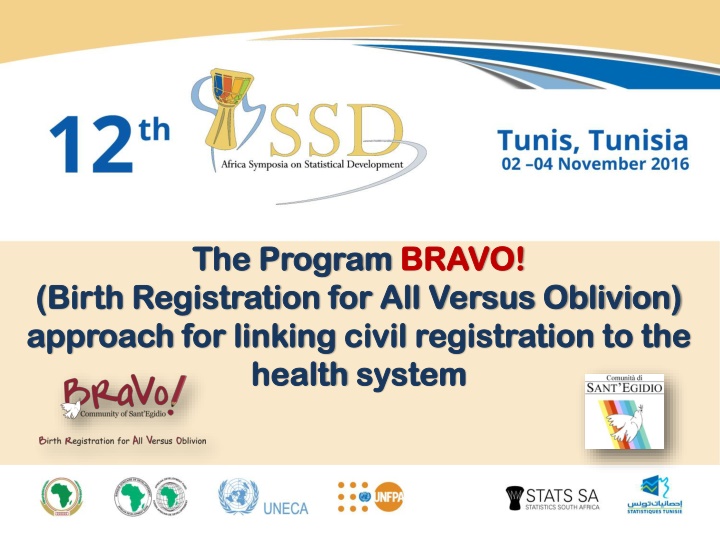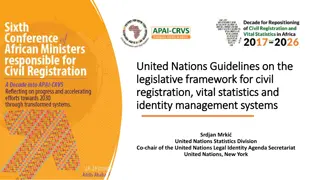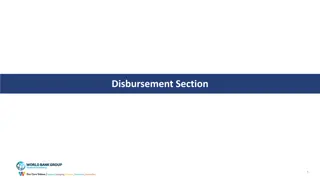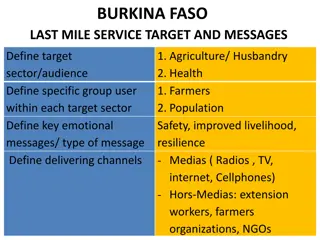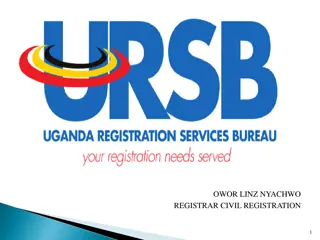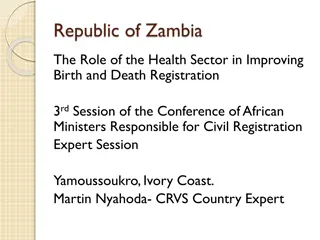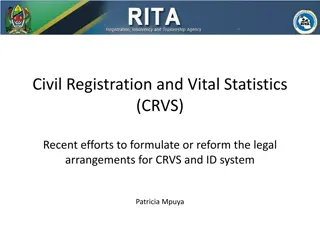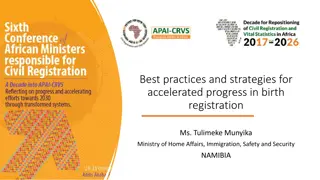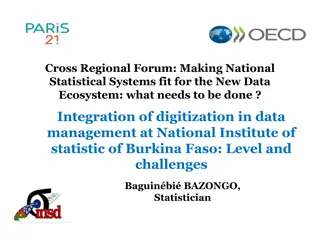BRAVO! Birth Registration Impact Evaluation Study in Burkina Faso
BRAVO! (Birth Registration for All Versus Oblivion) is a program collaborating with governments in Burkina Faso, Malawi, and Mozambique to link civil registration to health systems. The impact evaluation study in Burkina Faso's Sangui province shows the positive effects of opening stable registration centers in health facilities. Significant increases in birth registrations were observed, with a focus on children born or vaccinated within 60 days. The data collected highlights the success of the program in promoting birth registration and issuing birth certificates.
Download Presentation

Please find below an Image/Link to download the presentation.
The content on the website is provided AS IS for your information and personal use only. It may not be sold, licensed, or shared on other websites without obtaining consent from the author.If you encounter any issues during the download, it is possible that the publisher has removed the file from their server.
You are allowed to download the files provided on this website for personal or commercial use, subject to the condition that they are used lawfully. All files are the property of their respective owners.
The content on the website is provided AS IS for your information and personal use only. It may not be sold, licensed, or shared on other websites without obtaining consent from the author.
E N D
Presentation Transcript
The Program The Program BRAVO! (Birth Registration for All Versus Oblivion) (Birth Registration for All Versus Oblivion) a approach pproach for for linking linking civil civil registration health health system BRAVO! registration to the system to the
BRAVO! BRAVO! collaborates collaborates with the Burkina Faso, Malawi and Burkina Faso, Malawi and Mosambique with the Governments Governments of Mosambique of In Burkina Faso In Burkina Faso 13 13 registration registration centers centers In Malawi In Malawi 4 4 registration registration centers centers In In Mozambique Mozambique 10 10 registration registration centers centers
Impact Impact evaluation evaluation study in the Sangui province, Burkina Faso in the Sangui province, Burkina Faso study
Method o Stable registration centers have been opened in every health facility of the urban district of R o (68.000 inhabitants) and of the rural district of Godyr (22.000 inhabitants), promoting birth registration of children born or vaccinated there. o The two study districts are compared with two comparable control districts (Yako and Gomponsom). o Retrospective data of birth civil registrations in the time allowed by the law (60 days from birth) have been collected for the districts. o Data from birth civil registers and selected data collected from health registers for delivery and vaccination are captured in a database and compared, in order to assess how many children get out of birth registration procedure. o The impact evaluation study has been conducted for 12 months, in order to avoid distorting effects due to seasonality. Impact evaluation study of the opening of birth registration centers in the health facilities that provide neonatal services (delivery, vaccination, pre- and postnatal care) at a very decentralized level. 4
Increase Increase in in birth birth registrations registrations The number of birth certificates issued in the time allowed by the law have increased extremely comparing to the previous months both in R o and in Godyr. In Godyr we notice an increase of 357% In R o of 453%.
Data o The children recorded in the civil registers for birth and in the health registers for delivery and vaccination, as long as born in the two districts and less than 60 days, are eligible for the study. o During the 12 months of the study, 3.288 eligible children were registered in the database collecting the data of the study. o 87,41% of them received their birth certificate. o The birth registration rate of newborns (0-60 days) far exceeds the registration rate estimated for the Centre-Ouest region (62% of children 0-5 years MICS estimates 2010. o The majority of children attended the health facility two times in the first two months of life: at birth (registered in the Registre des accouchements AC) and for the first vaccination (registered in the Registre des vaccinations VC). A narrower number of children were just born or vaccinated there. o Crossing data form birth civil registers to those of health registers for delivery and vaccination we have a comparison between the number of children 0-60 days old who have had access to the services of the health facilities and the number of birth certificates issued to them. 6
Increase in birth registrations for selected groups of children 87.41% 86.92% 3,288 total ELIGIBLE CHILDREN total REGISTERED CHILDREN 3,149 2,874 2,737 91.95% 2,311 2,125 70.63% 76.05% 504 100.00% 356 334 254 139 139 GRAND TOTAL AC+VC AC ONLY VC ONLY ALL NA ONLY 7
Data o Birth registration among children born and vaccinated in the health facilities is 91,95%. o Among those just born in the health facility is 70,63% and among those just vaccinated there is 76.05%. o Interestingly, 139 children came to the health facilities only for birth registration without attending any of the health services. o There is a significant number of children (10%) who came for vaccination being born in another district of the country or in Cote d Ivoire. These data should provoke reflection in the legislator on how to manage in the most fair and efficient manner high mobility of the population, in order to avoid lack of registration or false statement. 8
Challenges o We could compare the registered children with the children attending health services, we actually don t know the real figures of the children born in the study districts. We can assume that those children that get off the health system are the most vulnerable and need to be reached both from the health and civil registration systems. o 12,59% of the children attending health services haven't been registered at birth. Our aim is to reach 100% of the newborns. o No death registration have been recorded in the period, although infant death rate in the region is 87 per 1.000 and in the interviews with the families some death is recorded. High coverage of birth registration and good performances of civil registration centers will probably help people understand the value of all registrations, including death registrations. 9
Conclusions o The data shows the very positive outcomes of linking civil registration to the health system for the increase of birth registration rate. o This method is very cost effective and have positive outcomes both for the civil registration and for the health system. o Very interesting developments will also result to the organization of health services from the computerization of data on newborns in the district, in order to promote the completion of the vaccination course, the periodic review of health, etc. o It will be critical to undertake positive actions in order to reach all families receiving health care. 10
